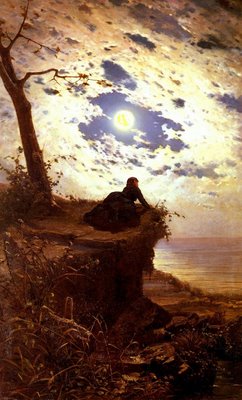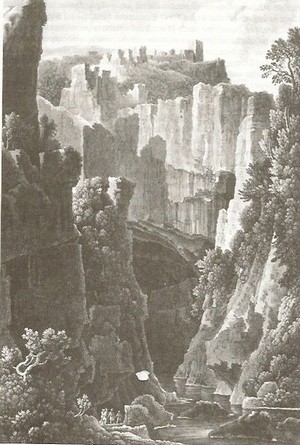Ellen and Jim Have a Blog, Too
We are two part-time academics. Ellen teaches in the English department and Jim in the IT program at George Mason University.


The Female Gothic and _Northanger Abbey_ · 8 September 08
Dear Friends,
I reread Austen’s Northanger Abbey on Saturday afternoon; and between then and now (with time off for the duties and activities of life), and studies of the gothic, including the female variety. I’m working on getting a thesis for the paper I’ve promised to give in early November at Eastern Region ACESC in DC: “The Ungothic Northanger Abbey; or, It’s Surprizing What Tricks Memory Plays upon us when it comes to the Gothic.”
Alfonso Simonetti, Ancor Non Torna, illustration for 19th century Italian translation of Radcliffe’s Romance of the Forest
After all I’m going to argue that NA is female gothic beyond the passages everyone misremembers as really there (instead of what the narrator asserts is not there). Through a good deal of the book Catherine is deeply absorbed by Mysteries of Udolpho, and I’m going to try to say why.
One will be centrally useful to me: Anne Williams’s The Art of Darkness: A Poetics of Gothic. It’s superb and does for this literary subgenre what Jessica Benjamin, Dorothy Dinnerstein, and Carol Gilligan did for female psycholgy. A new way of seeing that validates and liberates an ethical woman-centered view of womens’ experience. The Art of Darkness is feminist: Williams differentiates persuasively between male and female gothic; she shows how treating these as the same loses the meaning of female gothic particularly (as males do not recognize it as worth reading, real, or appealing), and its particular paradigms. Williams argues the female gothic far from being masochistic andenervating is empowering; we see the education of a young woman who integrates herself into her society on terms favorable to her. The woman who enjoy such books are not idiots; the male heroes at the center are the kindly good men of womens’ films, moral, yet distanced, undergoing an education themselves (to be more open and trusting of the woman). Such books show a girl overcoming the absence of her mother; presenting forms father as “the other:” unjust, tyrannical, greedy, a rapist.
Among the stills from the 2007 NA (screenplay Andrew Davies) I’ll use is will be Catherine (Felicity Jones) and Eleanor Tilney (Catherine Walker) walking in Eleanor’s dead mother’s favorite part of a wood:
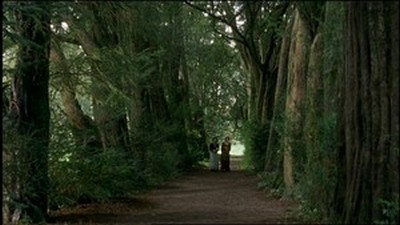
Catherine and Eleanor attempting to re-discover (like Psyche) her mother’s room:
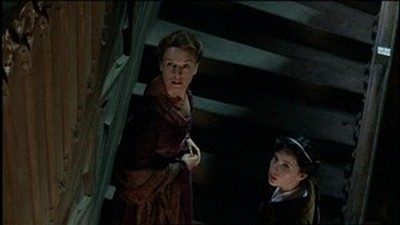
And General Tilney (Liam Cunningham, piercing eyes, thundering voice and all) stopping them:
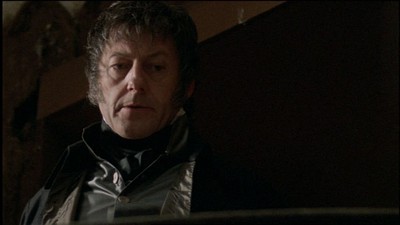
Williams’ arguments really fit Austen’s Northanger Abbey as much as they do Radcliffe’s masterworks with a heroine at the center (Sicilian Romance, Romance of the Forest, Mysteries of Udolpho). I feel good when I’m finished reading all of these; the costume drama films of NA (1987 BBE, screenplay Wadey, director Giles Foster; 2007 BBC/WBGH, screenplay Davies, director Jon Jones, are upbeat while acknowledging the cruelti desperation of those not able to free themselves of the cruelties of those in power over them. Williams’ idea is not the Oedipal but the Psyche paradigm is at the heart of many female gothics, and that makes sense: the heroine gets up with her candle and goes out to explore where she’s been forbidden to (usually by a man).
Revealingly, I’ve discovered The Art of Darkness was slammed or damned with faint praise by the learned critics in peer-edited periodicals who reviewed it. To a man (and they were all men) they disdained it, one was especially nasty (D. Richter). Why? Because of its feminism: how tiresome all this is; how she’s repeating what we all know already (not the Psyche paradigm). I realized as I read these disingenuous put-downs why feminism has been so erased in the academy. If you spend years and life’s blood on a book, and get this kind of response, I can see why it’s avoided.
A couple of summers ago on Eighteenth Century Worlds a few of us read Charles Brockden Brown’s Wieland and came to the conclusion, “horrid” referred to terrifically scary and horrible (unnatural in some way) brutalizing sex experiences of this book. These was thrilling to readers; it belongs to the male gothic. The frisson is the female readers’ unexamined awed sense of violation.
Williams’s approach is backed by a book in Italian: Beatrice Battalgia Paesaggi e misteri, riscoprire Ann Radcliffe (Landscapes and mysteries, rediscovering/uncovering Ann Radcliffe). Battaglia supplements Williams’ case by showing how the sublime landscapes & picturesque sequences in Radcliffe, allow for adventure, freedom, subversion, escape, individual ecstacy which escapes the tyranny of the bourgeois repressed order of greed, of war, of male hegemony, a visionary terrain. Terry Castle and others have said Radcliffe is not gothic but sentimental, but this is a position which could lead to dismissing her; Battalgia talks about poetry, the poetry of pictures, language, and verse in Radcliffe. Sublime landscape and picturesque rightly allure.
Veduta della grotto presso Sainct Kesian, Paris 1802
In a less exalted style Robert Miles makes many of the same points as Battaglia: Ann Radcliffe the great enchantress prefers rather to dwell on the implied revolutionary politics (anti-ancien regime, pro-progressive Whig).
I’m so angry at Eva Kosofsky Sedgwick’s The coherence of Gothic Conventions. Although I’ve learned to read this kind of jargon, this book is still not readable. She may be just a lot of hot air after all—smoke and mirrors with intimidating cover-up terms that end up doing will on interviews and I guess lead to tenure. I can’t find any reviews that go beyond her central idea, stated early: the astonishing reality that the gothic conventions all occur together, at once, and from the earliest books we recognize as gothic. The rest of the book fails to say why as far as I can see. Very irritating to think something’s there; but maybe (as I say) not.
From a little known longer poem by Radclife, The Sea-Mew
Forth from her cliffs sublime the sea-mew goes
To meet the storm, rejoicing! To the woods
She gives herself; and borne above the peaks
Of highest head-lands, wheels among the clouds,
And hear Death’s voice in thunder roll around,
While the waves far below, driven on the shore,
Foaming with pride and rage, make hollow moan.
Now, tossed along the gale from cloud to cloud,
She turns her silver wings touched by the beam,
That through a night of vapours darts its long
Level line; and vanishing ‘mid the gloom,
Enters the secret regions of the storm;
But soon again appearing, forth she moves
Out from the mount’nous shapes of other clouds,
And, sweeping down them, hastens to new joys.
It was the wailing of the deep she heard!
No fears repel her: when the tumult swells,
Ev’n as the spirit-stirring trumpet glads
The neighing war-horse, is the sound to her.
O’ver the waves hovering, while they lash the rocks,
And lift, as though to reach her, their chafed tops,
Dashing the salt foam o’ver her downy wings,
Higher she mounts, and from her feathers shakes
To shower, triumphant: As they sink, she sinks,
And with her long plumes sweeps them in their fall,
As if in mockery; then, as they retreat,
She dances o’ver them, and with her shrill note
Dares them, as in scorn.
Bird! .
............... with thee I’d fly
To the free waters and boundless skies,
And drink the light of heaven and living airs;
Then with thee haunt the seas and sounding shores,
And dwell upon the mountain’s beaked top,
Where nought should come but thou and the wild winds.
O bird! lend me thy wings,
That swifter than the blast I may out-fly
Danger and from’ yon part the life—boat call.
Bird of the winds and waves and lonely shores,
Of loftiest promontories—and clouds,
And tempest—Bird of the sun-beam, that seeks
Thee through the storm, and glitters on thy wings!
O bird of joy! What wanderer of air
Can vie with thee in grandeur of delights,
Whose home is on the precipice, whose sport
Is on the waves? 0 happy, happy bird!
Lend me thy wings, and let thy Joys be mine!
Ellen
--
Posted by: Ellen
* * *
Comment
- P.S. I find Simonetti’s painting also done as an illustration intriguing: It’s very much in keeping with illustrations of Walter Scott, and recent movies I’ve seen of the costume drama variety (not the elite kind of celebration of genteel rich that Aristocrats does, alas, fall into) where we see heroines out in the wilderness drawing, often somewhat crippled either emotionally or physically.
Ellen
— Elinor Sep 9, 3:00pm # - Like many of my blogs, this blog started life as a posting on one of my three lists (Eighteenth Century Worlds and Women Writers through the Ages, both):
I wrote on ECW yesterday after I put it up:
I’ve rewritten my posting yesterday on Anne Williams and books on the gothic, polished, re-thought and added stills from the 2007 NA and a poem by Radcliffe.
In reply from Clare:
“I went to the site Ellen and was intrigued how you had polished the original post, which at the time I already thought was fine. I really enjoyed the additions . I just wish I had the same patience when writing. I suppose I reserve that for my music.
I loved [the picture]. The sky reminds me of some of the sunsets we get here over the bay. It's so moody, Mrs Moody. Sorry, couldn't resist that, but it is excellent. It must have looked great as a an illustration to a gothic novel. Thanks for letting us see it, and well done for finding it.”
— Elinor Sep 10, 10:18am # - I had written to Tom:
“Anne Williams is wordy and could be 1/3 the length, but when she gets to her main points (about female gothic, the psyche story) she’s superb (see blog on gothic and NA),”
and he replied:
“Thanks much for your kind reply. You should know that when you enthuse over a particular book on your blog I almost invariably want to check it out for myself. Most recently, Rita Goldberg’s and, last night, the Anne Williams. Believe it or not, the Queens Public Library has both of these titles and I’ve ordered them to be delivered to my local branch. (Goldberg’s is a “scarce” book in commerce it would seem). I frequently like to buy whatever I’m reading in these areas of interest, however and so forth…but I’ll look at these borrowed copies first.
Where are you finding copies of these books you mention? How is your university library? Inter-library loan any good? Or do you buy them straight away, maybe only after you’ve borrowed a copy to see if you need to own one?”
to which I wrote:
“Dear Tom,
I obtain books in different ways. Mostly I do buy them: if I have read an excerpt, and know the content is good, and the price is not too high (under $20), I will buy them without taking them out of the library first. I often do buy them after taking them out of the library, for I want to have them to refer to, to use when I’m ready, and I do just love building my library. I try to restrict buying to my interests of course, but I know I tend to buy when I’m doing a review or working on a paper. I just bought A. Walton Litz’s book on Austen as reading an excerpt on NA I realized how good it is.
On more expensive books I feel I want to have or need(and many are so high), I get them from the GMU library or through their interloan library service. I used to xerox whole books before the internet and still very occasionally do. I calculate how much it costs per page for the xerox and go to Kinko’s.”
I should have said the Rita Goldberg is one I have out from GMU - as I have a bunch of books on _Clarissa_ and Richardson. They are all too expensive to buy and too much trouble to xerox. I can keep them out for months as a staff/faculty member. Many books on Austen are cheaper as she's so popular and these come out in paperback :).
The Williams I bought a couple of years ago. This happens and now it's coming in handy just when I want and need it. That's how I work; I buy ahead and bingo when I want the book, I have it. I do stay within my interests -- gothic is one of them.
Ellen
— Elinor Sep 11, 10:48pm #
commenting closed for this article

